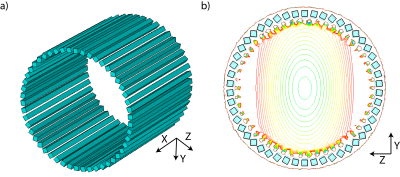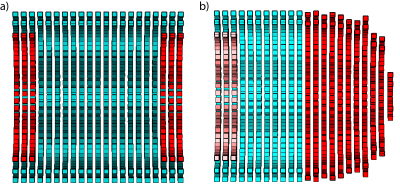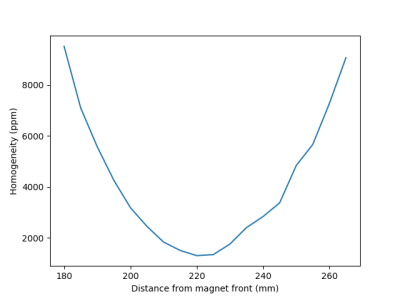4041
The design of a low-weight homogenous Halbach helmet for imaging the adult brain.1C.J. Gorter Center for High Field MRI, Leiden University Medical Center, Leiden, Netherlands
Synopsis
Arrays of permanent magnets have shown promise as a relatively light weight, low cost, sustainable way of generating magnetic fields suitable for MRI. In this work we show the design of a new homogenous helmet shaped, Halbach-array based magnet optimized for imaging the adult head. The magnet has a mean magnetic field strength of 59.7 mT and a homogeneity of 1313 ppm over a brain sized 25x20x15 cm3 ellipsoid. By truncating one side of the magnet the weight of the system has been reduced compared to symmetric designs while increasing the obtained field strength.
Introduction
Permanent magnet based MR systems have seen renewed interest in recent years driven by an interest in bringing MRI to areas that it has not historically been able to serve due to the high cost, large size and extensive infrastructure needed for conventional high field systems based on superconducting magnets. Commercial permanent magnets bases systems have typically used yoked magnet designs that, while capable of achieving high B0 field homogeneity and strength, are heavy due to the thick iron plates that are used as a magnetic flux return path[1]. More recently permanent magnets suitable for in-vivo MRI have been constructed using Halbach arrays that remove the need for the iron yoke and as a result can be made much lighter while maintaining a relatively high magnetic field strength[2-4]. One of the challenges of designing Halbach based magnets is that while an infinitely long cylindrical dipolar Halbach array has perfect B0 homogeneity this homogeneity is significantly reduced in the case of finite length Halbach systems[5]. The fact that Halbach arrays are made using a large number of permanent magnets provides flexibility in the design of these systems and can be used to overcome the field perturbations caused by this finite length. In this work we show the design of a 60 mT homogeneity-optimised ‘Halbach helmet’ for adult head imaging. The system has a 27 cm diameter open bore to accommodate the head while the rear of the magnet is truncated to reduce the total size and weight of the system.Method
The magnet design is derived from a cylindrical dipolar Halbach array with 22 rings of two concentric layers of 12×12×12 mm3 NdFeB N48 magnets. The orientation of the magnetic field of the Halbach array was chosen to align with sagittal axis of the brain to exploit the elliptical B0 isocontours that appear in finite Halbach arrays (see figure 1). The magnet is designed using two-stages of optimization to deal with the highly asymmetric design. The first stage is to do a coarse optimization of a cylindrical Halbach array with a constant ring diameter by placing an additional layer of magnets at the inside of the front rings of the magnets: at this stage the magnet is symmetric along the cylinder axis. The aim of this stage is to reduce the field drop off towards the front of the magnet, for which the second stage of optimization, which focuses on the closed rear of the magnet, cannot compensate for. In the second optimisation stage the radii of the rear 11 rings were allowed to decrease in 3 mm step size where each 3 mm reduction in radius also reduced the number of magnets in each of the two layers of the ring by a single magnet. The optimization was performed in python and approximated the magnets as ideal dipole sources. A genetic algorithm was used to maximize the magnetic field homogeneity over a 25x20x15 cm3 ellipsoid centered 20 mm off-center towards the rear of the magnet: a population size of 250,000 was used and allowed to evolve over 100 generations. Total computational time was approximately 24 hours. The result of the optimization was then simulated in CST microwave studio (Dassault Systèmes, Vélizy-Villacoublay, France) using the low-frequency solver to confirm the results.Results
Figure 3 shows the result of the magnet optimization. The front three rings of the magnet have three layers of magnets (same configuration as shown in figure 2a), the subsequent 11 rings have two layers due to the reduced ring radius to produce a helmet-like structure. Figure 4 shows simulated magnetic field plots over 3 planes centered at the most homogenous point of the magnet, which is located 220 mm from the front of the bore as shown in figure 5. The homogeneity over a 25x20x15 cm3 volume of interest is 1313 ppm with a mean magnetic field strength of 59.7 mT.Discussion
We show the design of a homogenous asymmetric head-only Halbach array with a sufficiently large bore for adult head imaging. By truncating the rear of the magnet, and making it more closely follow the shape of the volume of interest, the weight of the system compared to a symmetric system constructed previously by our group[4] has been reduced from ~75 kg to ~65 kg while increasing the B0 field strength by from 50 mT to 60 mT. While, based on experience, the homogeneity of the constructed magnet currently being constructed will be reduced compared to simulations, shimming can be performed through the addition of small NdFeB magnets.Acknowledgements
This work is supported by the following grants: Horizon 2020 ERC FET-OPEN 737180 Histo MRI, Horizon 2020 ERC Advanced NOMA-MRI 670629, Simon Stevin Meester Award and NWO WOTRO Joint SDG Research Programme W 07.303.101.References
[1] Hyperfine.io
[2] Cooley C. et al. A portable scanner for magnetic resonance imaging of the brain. Nat. Biomed. Eng. 2020
[3] McDaniel et al. The MR Cap: A single‐sided MRI system designed for potential point‐of‐care limited field‐of‐view brain imaging. Magn Reson. Med. 2019; 82:1946-1960
[4] O’Reilly T et al. In vivo 3D brain and extremity MRI at 50 mT using a permanent magnet Halbach array. Magn. Reson. Med. 2020;85:495-505
[5] Turek K et al. Magnetic field homogeneity perturbations in finite Halbach dipole magnets. J. Magn. Reson. 2014;238:52–62
Figures



